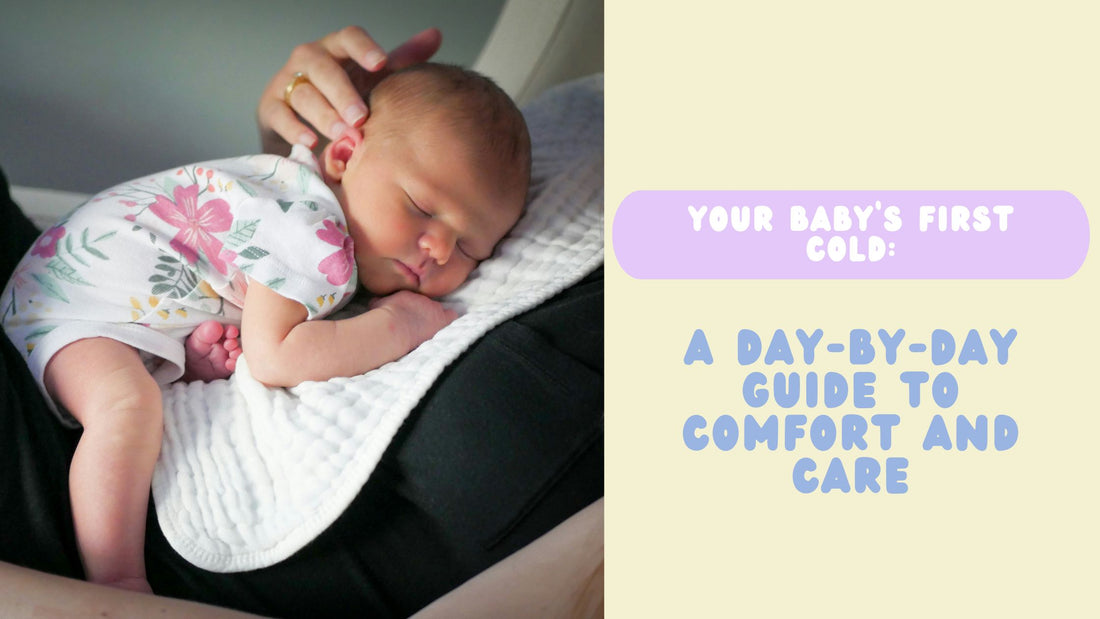
Your Baby’s First Cold: A Day-by-Day Guide to Comfort and Care
Share
Caring for a little one with a cold can feel like a long journey, but understanding the process can make it easier. Colds are common, especially in children, and while you can’t speed them up, you can help your child feel more comfortable along the way. Here’s what you need to know about colds and how to care for your child through each stage.
The Life of a Cold: What to Expect and How to Help Your Baby
What Is a Cold?
A cold is an upper respiratory infection caused by over 200 different strains of cold viruses. These viruses:
- Spread through sneezes, coughs, or touching contaminated surfaces like toys or doorknobs.
- Can live for hours on hands, towels, and other objects.
- Are extremely common—most kids catch 9 to 10 colds a year.
Prevention Tips:
- Frequent hand washing for 20 seconds - encourage your kids to sing "Happy Birthday" twice while scrubbing or use this handy hand washing timer.
- Covering mouths when sneezing or coughing.
- Avoid sharing cups, utensils, or towels.
Days 1–3: The Early Stage
The cold virus enters through the nose or mouth, irritating the tissue.
Expect:
- Symptoms: Runny or stuffy nose, sneezing, scratchy throat, and possibly watery eyes. (to avoid a raw nose we suggest Boogie Wipes with vitamin e and aloe and the Frida Snotsucker)
- Thicker secretions than usual, as the body responds to the virus.
- A low-grade fever is possible as white blood cells fight the infection.
How to Help:
- Offer lots of fluids to keep mucus loose.
- Provide extra rest (and extra cuddles).
- Use a cool-mist humidifier to keep the air moist.
Days 4–7: The Halfway Point
By now, the virus is in full swing. Symptoms may shift:
- Thicker, yellowish snot as dead cells and white blood cells are shed.
- Sneezing and congestion may persist, leading to mouth breathing and a dry throat.
- Redness around the nose from wiping and blowing.
How to Help:
- Apply a little petroleum jelly to soothe irritated skin around the nose.
- Offer warm liquids or saltwater gargles for dry throats (if age-appropriate).
- Keep the thermostat at 67–68°F and use a humidifier to ease congestion.
Days 8–10: The Final Stretch
Most colds run their course in about 10 days, though some can last up to two weeks. During this stage:
- Lingering coughs may occur as the body clears out irritants.
- Symptoms like congestion and sneezing should taper off.
Always Call a Doctor If:
- If your are concerned at all
- Symptoms last longer than two weeks or worsen.
- There’s thick green or yellow mucus for 7+ days.
- Your child shows signs of a secondary infection (e.g., fever returning, wheezing, or difficulty breathing).
Babies and Colds
Colds can be especially tough on babies because their tiny airways make it harder to manage mucus. Most babies catch their first cold between 1 and 3 months. Symptoms include:
- Runny nose, slight cough, and low-grade fever.
- Difficulty feeding or sleeping due to congestion.
How to Help Your Baby:
- Cool-Mist Humidifier: Keeps airways moist.
- Elevate the Head: Slightly raise one end of the crib mattress (check with your pediatrician first).
- Bulb Syringe/Baby Nose Aspirator & Saline Drops/Spray: Thin mucus with saline, then gently suction it out.
The Power of Rest and Routine
Colds can be exhausting, but they’re also a chance to slow down and focus on comforting your child. Offer plenty of fluids, keep them cozy, and remind yourself that this too shall pass.
Sleep training should never be performed when a baby is sick. If you have started, stop and wait for your little one to feel better before starting again.
With care and patience, the cold will run its course, and your little one will be back to their usual self soon. ❤️
#SimpleParentingPlans
Disclaimer: This content is for informational purposes only and is not a substitute for professional medical advice, diagnosis, or treatment. Always consult your pediatrician or a qualified healthcare provider with any questions you have about your child’s health. If you are ever concerned about your child’s symptoms or wellbeing, seek medical attention immediately.
As an Amazon Associate, I earn from qualifying purchases. I only link to products that I truly believe in. This means I may earn a small commission when you click on links to Amazon products in this post, at no additional cost to you. Thank you for supporting Simple Parenting Plans!
